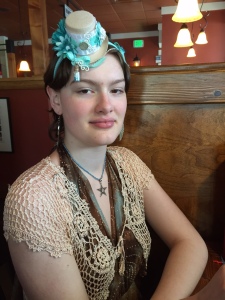
Photo from Fit Tip Daily
In last week’s post, I touched briefly on transcripts and preparing for universities. A number of sites go into detail about transcripts, forms, and requirements by state. What I wish to focus on is how we’re preparing Daughter for her potential foray into Running Start, which begins by taking the Compass test.
In Washington state, Running Start allows students of junior and senior high school level to take college courses at any community college tuition free, so long as they are able to pass the ACT Compass test and maintain a 2.0 for the (up to) two year duration. If a student completes a full two years, they graduate with both a high school diploma and an Associates degree (Arts or Sciences depending on the student’s choices).
This not only gives the students a boost and offers them great opportunities for transferring to four year universities or heading out to explore other avenues of life (e.g. starting a career, volunteering, taking a one year walkabout, etc.), but also significantly reduces the cost of completing a four year degree. I took Running Start, and though I didn’t complete either my Associates or Bachelors right away, it both offered me a chance to flourish in an environment more challenging and supportive than my high school, and it brought me to my significantly lower student loans to pay off (around $5,000 thanks to scholarships and only two years at uni).
Also to note, Washington State requires homeschoolers test their students once a year, either with a standardized test with proctor of their choosing, or with a one-on-one evaluation. The Compass test counts as our annual test.
So, here’s our plan for preparing Daughter for the rigors and expectations of community college life. Keep in mind, these are lessons we’re giving her to strengthen areas she finds most challenging. If you’re planning to teach strategies for entering college, whether early in a similar program or post-graduation in high school, please tailor them according to the needs of your children.
This is a long post, so the sections, in case you wish to skip ahead are Discussions, Practice, and The Plan.
DISCUSSIONS
How Running Start Works
College Expectations and Consequences
Comparisons between accessible community colleges
Importance of Calculus*
I won’t call these lectures, but sometimes they feel like it, as my daughter’s eyes glaze over. I broke each of these into different discussions so it didn’t overwhelm her; I wanted her to retain most of the information and that wasn’t going to happen by throwing it all at her at once. She does participate and ask questions when we stop to breathe, but sometimes it feels like she changes her mind about wanting to go to college every other day. One day passion, the next day ambivalence or downright resentment.
We chalk it up to the teen brain and move forward, as these discussions, while initially set aside as one-on-one time, are on-going through our process each week. (I’ll post more on the teen brain at a later date.)
These discussions involve sitting down for twenty or thirty minutes and chatting about each topic. I actually have the lists in this post on a Drive document and refer to them as we’re talking. I’ve already mentioned how Running Start works, but if you’ve never been in a community college or university, the expectations are those given adults, not children. While there’s a great deal of freedom of choice and movement around a college campus compared to formal high schools, it comes with the same responsibilities of having said freedoms.
It’s incumbent upon every student, whether 16 or 65 to keep track of required credits, keep a balanced course load relevant to one’s experience, know what prerequisites are most needed, and how to manage one’s time both in and outside of the classroom. Since time management and organization are my daughter’s two greatest banes, my partner and I are working to support her growth in these areas. After all, if she does poorly in Running Start, those grades remain on her transcripts indefinitely and affect her future college GPA. Having realistic expectations and consequences described ahead of time allow her to go into this program fully informed.
We spoke about what a reasonable course load would be for a first time student. I told her since her Composition 1 & 2 classes would be prerequisites for almost everything else, she should start with one of them first. If possible, I added she should try to get in to the beginning Japanese course, since she wishes to travel to, and possibly study or live in, Japan. I told her it can be hard as a Freshman to get the first choice language, but if she can, she should. (We checked both community colleges on our bus lines to see if either of them had Japanese, they had both, which means we do still need to have the comparison check, which will include course listings, programs, student reviews, bus schedules, and more, community support, and more).
Since students need to be taking a full course load each quarter, Composition and Japanese (or a different language) would already be taxing in terms of reading, writing, and memorizing. I suggested she add an elective her first quarter in something that supports her dreams, such as an art class, or similar. She may still have studio time or sketchbook homework to complete outside of class, but it wouldn’t be in the same vein as the other two and would make her happy and not feel like work.
*This one is entirely on my partner. While I can talk about how wonderful Calculus is if you’re entering the sciences or you’re an amateur physicist trying to understand the universe, I’ve yet to find myself needing Calculus as a writer, mother, anthropologist, community organizer, housekeeper, personal chef, model, artist, performer, etc. Algebra and Geometry, on the other hand, now THEY’RE important to have a solid grasp of in daily life no matter your profession or interests. Thus, we’re leaving this discussion entirely up to him, because he thinks she should take it in case she decides she wants to explore a different path than she’s already expressed wanting to take. He wants her to have options. I get it. I do. But try convincing a 15 year old of that.
PRACTICE
Note-taking
Essay writing
Time management
Test taking
Compass Test practice
 Each of these skill sets are necessary to support her learning. While both of us have tried to teach her note taking and time management skills, she continues to struggle with them. We’re going back to some basics we went over back in middle school. How to take effective notes, various methods of taking notes, and trying each of them in turn to see what helps her best. We even discovered a Japanese method of making best use of notes, which we thought she’d like. We have a tall stack of composition books now, and she’s using one for math, one for essays, and another for note taking while reading.
Each of these skill sets are necessary to support her learning. While both of us have tried to teach her note taking and time management skills, she continues to struggle with them. We’re going back to some basics we went over back in middle school. How to take effective notes, various methods of taking notes, and trying each of them in turn to see what helps her best. We even discovered a Japanese method of making best use of notes, which we thought she’d like. We have a tall stack of composition books now, and she’s using one for math, one for essays, and another for note taking while reading.
Time management is trickier. I’m still playing around with ideas for how to help her, because most of my personal tricks rely on a certain awareness of time passing, which she really doesn’t have. I don’t think she ever had it, but neither does her father. It’s a fact, not a judgment, yet she still needs to find a way to work at some base level of skill or she’ll never make a deadline on an assignment. I’m playing with calendars — either helping her establish an effective use of the calendar on her phone, or getting her a small day planner she can carry in her satchel. I’ve even started a Pinterest board just to help me keep track of ideas for supporting her. Ok, so it’s mostly filled with humorous memes, but there are good, serious ideas in there as well.
Essay writing is an entirely too lengthy topic to discuss in this post, but I’m using an idea from a formal educator’s pin on Pinterest. It involves using a single composition book at a time to hold all of the reading notes, brainstorming questions, outlines, and essay drafts in one. With a specific organization laid out on the first couple of pages, she can work on building her ideas, asking questions, drawing up an outline, and writing out her essay, with space for reflection and revision along the way. Why hadn’t we done this sooner?
I’ve got a number of reasons, but it comes down to a long-term struggle with communication she’s had since her traumatic third grade year at a private school. Instead of pushing her to write essays in the past, we’ve worked more on getting her to think through her ideas and be able to discuss them, and now, I’m able to say to her, “an essay is simply a discussion with a really good listener at the other end.” She’s starting to get it, but there’s a lot of hand holding as she builds confidence. If only essays were like fanfiction, we’d be golden.
The final portion of this list: test taking and Compass test practice are intertwined. She’s familiar with test taking skills. My best friend says it every summer when we go to get our kids tested, “Tests don’t tell you how smart you are, they just tell you how good you are at taking tests.” In general education, this is a fair assessment in my view. Timed tests are especially stressful for kids with social anxiety, like my daughter. We’ve given her tools and tricks to use to get through them with ease and panache. She’s done quite well on multiple choice tests, but the essays might stump her, so we’re working on that (see above).
The Compass test only tests reading comprehension, essay writing (mostly correcting grammatical and spelling errors), and mathematics, although this latter subject is only used for placement. Maths are not seen as necessary to access Running Start, only the scores for the reading and writing are used for that purpose. Her mathematics score, though, will determine whether she’s at, above, or below college algebra level. If she’s below college level math, she’ll be required to take remedial courses at our expense until she’s brought up to snuff. My partner doesn’t want that to happen, so he’s plodding away through Algebra, Geometry, Trig, Pre-Calculus, and all the other high school maths some of us love and others hate (or like me, have mixed feelings about: Hooray, Algebra! Bah, Geometry! Huzzah, Quantum Physics! Suck it, Proofs!).
THE PLAN
Our ultimate goal: get our daughter the best opportunities available to advance her education and help her reach her personal goals (that will hopefully lead to a happy, responsible adult).
To do this, we’re having our discussions, working on our practice, and getting ready for the Compass test.
Both colleges have a recommended Running Start information session, and allow students to take the test once every thirty days for $17 a test. Not too bad, and it gives her a chance to try, fail, and try again long before deadline, which means a successful test into Running Start by May for 2016’s fall quarter.
She’ll be using practice tests we found online and those provided by the colleges to give her an idea of what she’ll be facing. Any information that’s completely foreign to her, we’ll help her learn. Any skills she’s flagging on, we’ll help her brush up on them. She’ll take one test in January or February to see where she falls. If she fails the first one, we’ll practice more in the areas she struggled with, and try again in a couple of months.
Though I know she’s academically ready for much of this test, I’m not convinced of its efficacy in determining her real abilities and obstacles. Nevertheless, she’ll be trying, and if she succeeds, she’ll enter Running Start next fall. Should she prove unable to pass the test, we’ll be able to acknowledge a need for more study at home until she’s ready to try again.
No matter what the outcome of the test, I’m still not sure I am ready for my darling girl to be a college student. It’s difficult enough having her be able to look over my head without standing on her tippy toes! But this is what parenting’s about. Making a new life, giving it love, teaching it skills, and hoping it will blossom in the ways it will. My ex gave me a child; I’m working on giving the world a compassionate, responsible adult. And boy is it a lot of fun, exasperating work.


 Each of these skill sets are necessary to support her learning. While both of us have tried to teach her note taking and time management skills, she continues to struggle with them. We’re going back to some basics we went over back in middle school. How to take effective notes, various methods of taking notes, and trying each of them in turn to see what helps her best. We even discovered
Each of these skill sets are necessary to support her learning. While both of us have tried to teach her note taking and time management skills, she continues to struggle with them. We’re going back to some basics we went over back in middle school. How to take effective notes, various methods of taking notes, and trying each of them in turn to see what helps her best. We even discovered 
